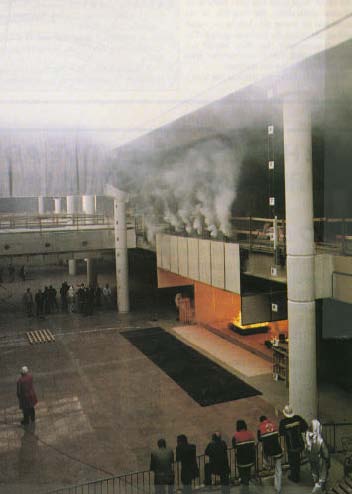Hot Smoke Test at Brussels Airport
This article describes the experimental tests carried out at Brussels Airport in April 1994 in which trays of industrial methylated spirits were burnt in order to assess the smoke venting system within the shopping mall of the new airport terminal building. The article describes the test fires, calculations, and the results.
On 27 and 28 April 1994 staff from the Fire Research Station, in collaboration with N.V. IFSET S.A., conducted a hot smoke test in the new, unfinished, terminal at Brussels Airport, in order to assess the smoke venting system.
THE BUILDING
The new terminal at Brussels Airport includes a large duty free shopping mall about 85 m long 12 m wide and 17 m high. Part of the fire protection system in this mall consists of a smoke exhaust ventilation system intended to ensure safe escape of shoppers from the two mall levels by maintaining any smoke layer above the heads of people on the upper level.
The vents were fitted into the glazed barrel vault roof, and, with a smoke curtain in the barrel vault, formed two reservoirs (one inlet, one outlet) each having 80m2 of vent area.
THE NEED FOR A TEST
Unlike most of the other active systems in a building, a smoke exhaust ventilation system that depends on natural buoyancy cannot easily be tested other than for simple mechanical operation of its parts. HVAC engineers can test their systems with an anemometer and sprinkler installers can test their systems with a pressure gauge. The smoke ventilation system, depending as it does on the buoyancy of hot smoke from a fire, cannot be similarly tested - except with a fire. In addition, the calculations used to design smoke venting systems are based on simple geometries and their application to more complex designs of building requires judgement and approximation. There is always the possibility that some unexpected or unusual feature in the building will overcome the safety margins. In addition, in all systems there is the possibility that a misunderstanding or error during design and/or construction could result in an installation that does not correspond to the design intention; or the smoke control system might interact with other systems in an unexpected way.
While the ventilation engineer will commission the completed system by tests and measurements, such a procedure has not usually been thought feasible for smoke
ventilation schemes.However, the Brussels Airport Terminal Company, BATC, wished to prove their system and the Fire Research Station collaborated with N.V. IFSET S.A. of Belgium to organise and carry out a test programme.
THE FIRE TESTS
The use of hot smoke tests for large buildings has been pioneered in Australians. An ad-hoc atrium test involving real fires was carried out in Preston in 1913.
The Fire Research Station (FRS) developed a method of test based on its experience of large fire experiments. When tailored to the present case each test consisted of a 2 MW industrial methylated spirits fire (IMS) (1 MW in each of two trays) that was burnt in a fire compartment specially built into a shop space to protect the structure close to the fire. The fire size was calculated to avoid heat damage to higher parts of the building structure and IMS was used since its combustion products contain no visible particles, are non-corrosive and largely non-toxic. The fire gases were made visible by the use of non-toxic and non-corrosive artificial white smoke that was introduced to the plume above the fire compartment. This smoke needed only to be sufficiently dense to make the smoke layer visible; it was not intended that it be as thick as real smoke from a 2 MW fire. Indeed, it was a requirement to be able to see through the smoke to judge details of its movement. Also, it was an advantage for the smoke to be thin in case the smoke control system did not work as expected since observers might then be engulfed in smoke.
The building, being not yet completely fitted out, was modified for the fire test by blanking off some openings in which doors or smoke screens had not yet been fitted. The decorative stone floor had already been laid and so had to be protected against heat. The smoke detection system was not active. In consequence, during the tests the vents were operated manually once the fire was established. The sprinkler system was in place but not charged. The test was planned around the need to ensure the safety of occupants and to avoid damage to the building.
INSTRUMENTATION
Instrumentation was deliberately kept to the minimum needed for the test. Thermocouples were used to measure the temperature of the hot gases emerging from the fire compartment and a thermocouple column was hung from the roof to measure the smoke layer temperature and also later to determine the smoke layer depth. Height markers were also hung from the roof so that observers could visually assess the smoke layer depth. There was extensive video and stills camera coverage of the tests.
CALCULATIONS
Calculations were carried out prior to the fire tests to select the optimum fire size, and after the test to extrapolate from the test results so as to predict the performance of the system with a 5 MW design fire in a shop. Calculations were based on published methodologies.
SUCCESS/FAILURE CRITERIA
Three criteria were used to assess the success of the smoke ventilation system:
i. The component parts of the smoke ventilation system operate according to design.
ii.The extrapolated calculations show that the system would be satisfactory for full design fire sizes.
iii No smoke affects parts of the building except those that were allowed for in the smoke ventilation design.
Since these tests assessed only one zone of the building it was still necessary to generalise from the results for the whole building.
RESULTS
Both tests proved successful in that the necessary results were obtained to enable the assessment to be carried out. The building was undamaged and remained completely safe throughout. (A large number of visitors observed the second fire test, including the Minister of the Interior).
In the latter part of both tests, at the request of BATC, the smoke vents were closed so that visitors could see the smoke layer deepen (the vents were reopened well before there was any risk to people in the building). As in all large-scale fire tests there were technical difficulties; for example in the second test all power was lost to the entire building just before the fuel was ignited. The vents demonstrated that they would fail open, as intended. Power was restored after some minutes and the test resumed. The weather during the test was fair with a light breeze.
CONCLUSIONS
The smoke venting system was clearly effective with the 2 MW fire in keeping the smoke layer well above heads of people both on the lower and upper floors. Calculations showed that even with the 5 MW design fire, the smoke venting system in the airport terminal building would work successfully. The tests did, however, identify a number of design features which allowed smoke to travel elsewhere in the building and which would need some remedial action. Smoke collected in some limited-area stagnant zones, which could cause problems for escape were people to linger and where it would be particularly important to ensure rapid evacuation.
Overall this hot smoke test successfully demonstrated the effectiveness of the smoke venting system in Brussels Airport and also the feasibility of a hot smoke test of this type.
ACKNOWLEDGEMENTS
This article has been published with the permission of the Brussels Airport Terminal Authority and the Chief Executive of the Building Research Establishment. The authors would like to thank their many colleagues who assisted with the project.

More News
RBFRS retain World Extrication Title
Royal Berkshire Fire and Rescue Service (RBFRS) Extrication Team has onc... Read more >
Portsmouth Guildhall filled with smoke for fire training exercise

PART of Portsmouth’s Guildhall has been filled with smoke as part ... Read more >
New Products

Concept have introduced a few new accessories / products:The Concept Vul... Read more >
Vulcan Demonstration Movie

Concept's new Vulcan Smoke generator was launched at WMFRS Training Acad... Read more >
New Air Trace

Concept are pleased to announce the re-designed Air Trace and the launch... Read more >
<<12345...>>

